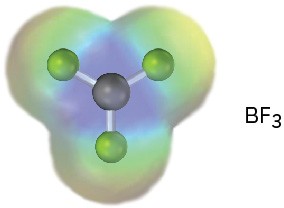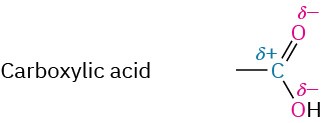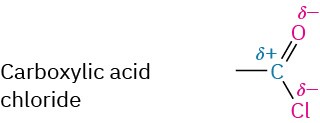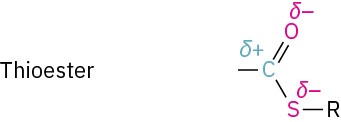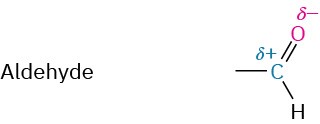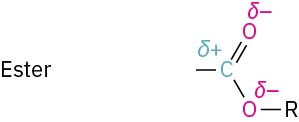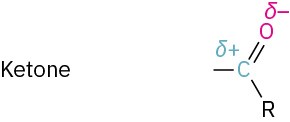6.3 Polar Reactions
Polar reactions occur because of the electrical attraction between positively polarized and negatively polarized centers on functional groups in molecules. To see how these reactions take place, let’s first recall the discussion of polar covalent bonds in Section 2.1 and then look more deeply into the effects of bond polarity on organic molecules.
Most organic compounds are electrically neutral; they have no net charge, either positive or negative. We saw in Section 2.1, however, that certain bonds within a molecule, particularly the bonds in functional groups, are polar. Bond polarity is a consequence of an unsymmetrical electron distribution in a bond and is due to the difference in electronegativity of the bonded atoms.
Elements such as oxygen, nitrogen, fluorine, and chlorine are more electronegative than carbon, so a carbon atom bonded to one of these atoms has a partial positive charge (δ+). Metals are less electronegative than carbon, so a carbon atom bonded to a metal has a partial negative charge (δ−). Electrostatic potential maps of chloromethane and methyllithium illustrate these charge distributions, showing that the carbon atom in chloromethane is electron-poor (blue) while the carbon in methyllithium is electron-rich (red).

The polarity patterns of some common functional groups are shown in Table 6.1. Note that carbon is always positively polarized except when bonded to a metal.
Table 6.1 Polarity Patterns in Some Common Functional Groups
|
Compound type |
Functional group structure |
|
|
|
|
|
|
|
|
|
|
|
|
This discussion of bond polarity is oversimplified in that we’ve considered only bonds that are inherently polar due to differences in electronegativity. Polar bonds can also result from the interaction of functional groups with acids or bases. Take an alcohol such as methanol, for example. In neutral methanol, the carbon atom is somewhat electron-poor because the electronegative oxygen attracts the electrons in the C−O bond. On protonation of the methanol oxygen by an acid, however, a full positive charge on oxygen attracts the electrons in the C−O bond much more strongly and makes the carbon much more electron- poor. We’ll see numerous examples throughout this book of reactions that are catalyzed by acids because of the resultant increase in bond polarity upon protonation.

Yet a further consideration is the polarizability (as opposed to polarity) of atoms in a molecule. As the electric field around a given atom changes because of changing interactions with solvent or other polar molecules nearby, the electron distribution around that atom also changes. The measure of this response to an external electrical influence is called the polarizability of the atom. Larger atoms with more loosely held electrons are more polarizable, and smaller atoms with fewer, tightly held electrons are less polarizable. Thus, sulfur is more polarizable than oxygen, and iodine is more polarizable than chlorine. The effect of this higher polarizability of sulfur and iodine is that carbon–sulfur and carbon–iodine bonds, although nonpolar according to electronegativity values (Figure 2.3), nevertheless usually react as if they were polar.
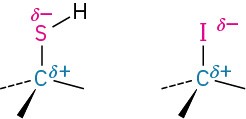
What does functional-group polarity mean with respect to chemical reactivity? Because unlike charges attract, the fundamental characteristic of all polar organic reactions is that electron-rich sites react with electron-poor sites. Bonds are made when an electron-rich atom donates a pair of electrons to an electron-poor atom, and bonds are broken when one atom leaves with both electrons from the former bond.
As we saw in Section 2.11, the movement of an electron pair during a polar reaction is indicated using a curved, full-headed arrow to show where electrons move when reactant bonds are broken and product bonds are formed during the reaction.

In referring to the electron-rich and electron-poor species involved in polar reactions, chemists use the words nucleophile and electrophile. A nucleophile is a substance that is “nucleus-loving.” (Remember that a nucleus is positively charged.) A nucleophile has a negatively polarized, electron-rich atom and can form a bond by donating a pair of electrons to a positively polarized, electron-poor atom. Nucleophiles can be either neutral or negatively charged; ammonia, water, hydroxide ion, and chloride ion are examples. An
electrophile, by contrast, is “electron-loving.” An electrophile has a positively polarized, electron-poor atom and can form a bond by accepting a pair of electrons from a nucleophile. Electrophiles can be either neutral or positively charged. Acids (H+ donors), alkyl halides, and carbonyl compounds are examples (Figure 6.2).
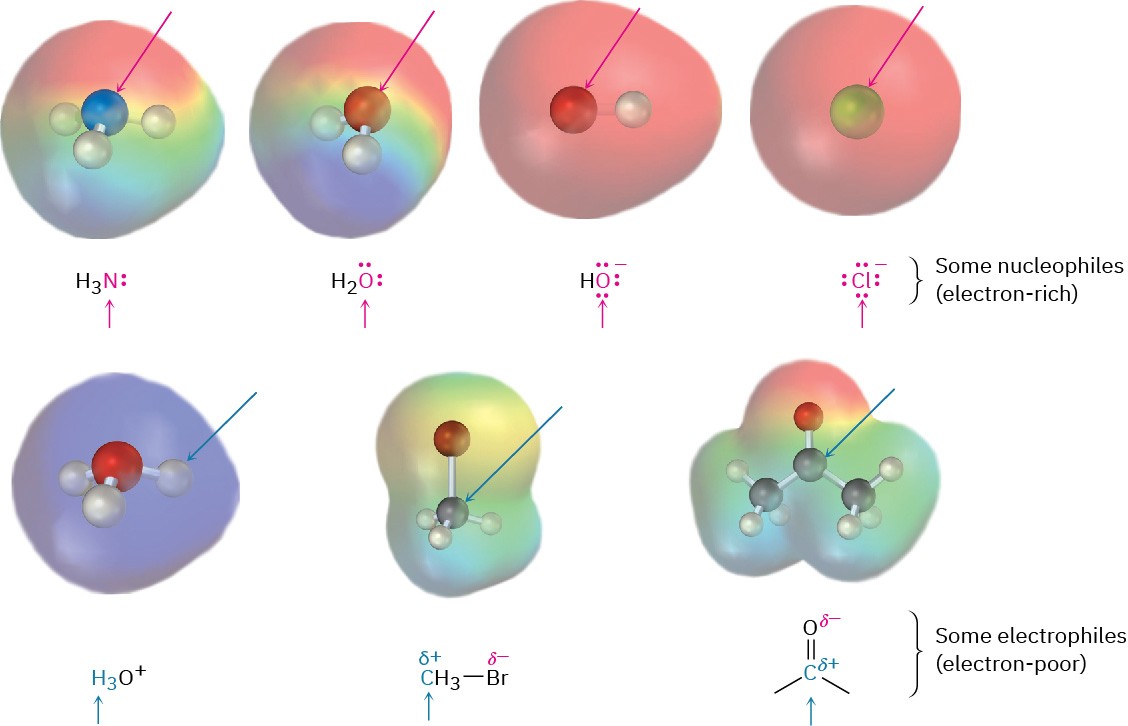
Figure 6.2 Some nucleophiles and electrophiles. Electrostatic potential maps identify the nucleophilic (negative) and electrophilic (positive) atoms.
Note that neutral compounds can often react either as nucleophiles or as electrophiles, depending on the circumstances. After all, if a compound is neutral yet has an electron-rich nucleophilic site, it must also have a corresponding electron-poor electrophilic site. Water, for instance, acts as an electrophile when it donates H+ but acts as a nucleophile when it donates a nonbonding pair of electrons. Similarly, a carbonyl compound acts as an electrophile when it reacts at its positively polarized carbon atom, yet acts as a nucleophile when it reacts at its negatively polarized oxygen atom.
If the definitions of nucleophiles and electrophiles sound similar to those given in Section
2.11 for Lewis acids and Lewis bases, that’s because there is indeed a correlation. Lewis bases are electron donors and behave as nucleophiles, whereas Lewis acids are electron acceptors and behave as electrophiles. Thus, much of organic chemistry is explainable in terms of acid–base reactions. The main difference is that the words acid and base are used broadly in all fields of chemistry, while the words nucleophile and electrophile are used primarily in organic chemistry when carbon bonding is involved.
Worked Example 6.1
Identifying Electrophiles and Nucleophiles
Which of the following species is likely to behave as a nucleophile and which as an electrophile?
(a) NO2+(b) CN−(c) CH3NH2(d) (CH3)3S+
Strategy
A nucleophile has an electron-rich site, either because it is negatively charged or because it has a functional group containing an atom that has a lone pair of electrons. An electrophile has an electron-poor site, either because it is positively charged or because it has a functional group containing an atom that is positively polarized.
Solution
- NO2+ (nitronium ion) is likely to be an electrophile because it is positively charged.
- :C≡N! (cyanide ion) is likely to be a nucleophile because it is negatively charged.
- CH3NH2 (methylamine) might be either a nucleophile or an electrophile, depending on the circumstances. The lone pair of electrons on the nitrogen atom makes methylamine a potential nucleophile, while positively polarized N−H hydrogens make methylamine a potential acid (electrophile).
- (CH3)3S+ (trimethylsulfonium ion) is likely to be an electrophile because it is positively charged.
Problem 6-2
Which of the following species are likely to be nucleophiles and which electrophiles? Which might be both?
(a) CH3Cl
(b) CH3S–
(c)

(d)

Problem 6-3
An electrostatic potential map of boron trifluoride is shown. Is BF3 likely to be a nucleophile or an electrophile? Draw a Lewis structure for BF3, and explain your answer.
